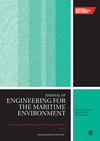管道几何形状对轮缘驱动推进器流体力学性能影响的数值分析
IF 1.5
4区 工程技术
Q3 ENGINEERING, MARINE
Proceedings of the Institution of Mechanical Engineers, Part M: Journal of Engineering for the Maritime Environment
Pub Date : 2024-04-09
DOI:10.1177/14750902241242248
引用次数: 0
摘要
本文基于计算流体动力学(CFD)方法,研究了风道几何形状对轮缘驱动推进器(RDT)流体动力学性能的影响。研究分析了风道厚度、风道前缘半径和风道后缘几何形状对推力系数、扭矩系数和效率的影响。结论表明,推力系数随风道厚度的减小而增大,但扭矩系数随风道厚度的增大而增大,因此效率随风道厚度的减小而增大。另一方面,风道前缘半径对 RDT 的推力系数没有显著影响。但 RDT 的扭矩系数随风道前缘半径的增大而减小,因此 RDT 的效率随风道前缘半径的增大而提高。综合比较表明,RDT 15-0.5 (风道厚度为 15 毫米,风道前缘半径与风道厚度之比为 0.5)在本文研究的 RDT 模型中具有最佳的流体动力学性能。本文章由计算机程序翻译,如有差异,请以英文原文为准。
Numerical analysis of the effect of the duct geometry on the hydrodynamic performance of rim-driven thruster
This paper studies the effect of the duct geometry on the hydrodynamic performance of rim-driven thruster (RDT) based on Computational Fluid Dynamics (CFD) method. The effect of the thickness of the duct, the radius of the leading edge of the duct and the geometry of the trailing edge of the duct on the thrust coefficient, torque coefficient and efficiency are investigated and analyzed. The conclusion shows the thrust coefficient increases with the thickness of the duct decreasing, however the torque coefficient increases with the increase of the thickness of the duct, so the efficiency increasing with the decrease of the thickness of the duct. On the other hand, the radius of the leading edge of the duct has no significant effect on the thrust coefficient of the RDT. However, the torque coefficient of RDT decreases with the increase of the radius of the leading edge of the duct, so the efficiency of RDT increases with the increase of the radius of the leading edge of the duct. A comprehensive comparison shows that the RDT 15-0.5 (the duct thickness is 15 mm, the ratio of the radius of the leading edge of the duct and the duct thickness is 0.5) has the best hydrodynamic performance among the investigated RDT models in this work.
求助全文
通过发布文献求助,成功后即可免费获取论文全文。
去求助
来源期刊

CiteScore
3.90
自引率
11.10%
发文量
77
审稿时长
>12 weeks
期刊介绍:
The Journal of Engineering for the Maritime Environment is concerned with the design, production and operation of engineering artefacts for the maritime environment. The journal straddles the traditional boundaries of naval architecture, marine engineering, offshore/ocean engineering, coastal engineering and port engineering.
 求助内容:
求助内容: 应助结果提醒方式:
应助结果提醒方式:


